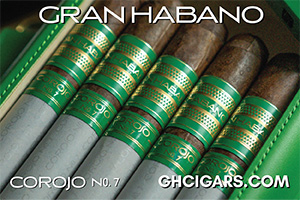Aging Cigars: Cello on Vs. Cello off
The curiosity of whether to age cigars with the cellophane on or off has been a topic of discussion for many years. So we wanted to discover the results for ourselves. Before anyone tells you the right way to do it, you need to know that the only right way is whatever suits your individual needs. There are a lot of factors you need to consider. Do you travel with your cigars? Do you plan on aging them a long time? Do you rifle through your humidor looking for cigars? Is the condition of your humidor regulated and have constant and consistent relative humidity and temperature?

Cigars, generally speaking, are ready to be enjoyed by the time they leave the factory but most cigars can stand up to a few years of age and a lot of them can stand up to many more. A cigar’s blend consists of different tobaccos that achieve a certain flavor and strength profile. Those tobaccos in the blend marry over time. The oils and flavors of these different ingredients become one. Eventually the only thing the aging process will do is diminish the strength and flavor while taking on the flavors of the environment they were aged in, absorbing everything like a sponge.
Consistency in temperature, humidity and starting with a cigar that you think will benefit from age are three main factors. That is essentially true for everything.
There is no debate in that the environment where cigars have been aged impact the outcome of how that cigar will smoke and taste. If you leave a milder flavored cigar in a cedar humidor for ten years it will taste like a cedar humidor at the end. There is no guideline for the appropriate length to age cigars.
Every cigar will age differently and once it tastes like a humidor or dry air you’ve gone too long. We go on and on about the subjectivity of flavor and when it comes to aging with the cellophane on or off, it’s no different. It all depends on what you like. There are certain benefits to keeping it on.
If I were to age cigars in a desktop humidor, I would leave the cellophane on. However, I have the privilege of being able to keep and age cigars in a walk-in humidor/cellar, so I age the cigars in their original packaging on metal racks. The room has neutral odors and mostly constant temperatures and humidity levels year round. I love desktop humidors and have a few. They are great for cigars that I enjoy now. I make sure they are stocked to share with family and friends at parties or events. There is something to be said for opening a humidor stocked with naked cigars and smelling all of the rich tobacco notes inside. It heightens the senses before you even taste the individual cigar. So when someone picks out a cigar, especially if they don’t have their own humidor, it adds to the romance of the overall experience. If the humidor has a big cedar smell, eventually that is what the cigars will take on in taste and smell over the course of years, or sooner depending on the type of cedar and condition of the individual humidor. If I didn’t have access to box storage and wanted to age a box, I’d use a Boveda pack inside a large Ziploc bag and put it somewhere that is constantly cool and leave it alone. When it’s all said and done it’s important to remember that cigars are an artisanal product and they are supposed to be enjoyed.
CELLOPHANE BENEFITS:
- Cellophane won’t impart off flavors into the cigar.
- The cellophane adds an extra layer of protection.
- Cigars that aren’t in cellophane will dry out faster.
- Cigars that aren’t in cellophane can get damaged, especially the wrapper, much easier.
- The cellophane slows down the aging process, and the cigar will retain a lot of its original aroma and flavor longer.
- Cellophane is handy for tagging and dating individual cigars you plan to age.
TEST SUBJECT: LA AURORA CIEN AÑOS Original Release
Churchill, 7 x 50
Box of 25
From 2003
Dominican Republic
Dominican
$14.00 Single
Created to celebrate La Aurora Cigar’s 100th anniversary. The original La Aurora cigars were an amazing example of the quality that La Aurora produces. We have had the cigars for this review since I purchased them years before Cigar Press Magazine premiered. These two cigars have been aged together in their original box, one with the cellophane on, and the other with the cellophane off. The box was placed in a large Ziploc bag and maintained with a 69% Humidipak (now Boveda) to help regulate and protect the environment inside the box directly. The walk-in humidor/cellar used for storage has a temperature range of around 65 degrees year round. The original Cien Años had a full body with full, rich, unique flavors and was a great candidate for aging in general and for this experiment in aging with or without cellophane.
CELLOPHANE OFF:

This cigar was silky to the touch with a slightly oily sheen and had a reddish-brown color. There was a very neutral pre-light smell that had a faint sweet graham cracker-like smell, which is much different than when this cigar was new. A lot of cedar on the pre-light taste. Definitely a lot of wood notes in the aroma and taste once lit. A very smooth texture, very little spice in the nose and palate. It had a slightly sweet tone in the aroma and a mouthwatering texture. Mild-medium with a long finish. It slowly built in strength as it was smoked, finishing medium overall. A woody note was very consistent in the aroma and overall character. Extremely balanced and enjoyable. Pleasant overall aroma and flavor with a slight rum-like sweetness.
CELLOPHANE ON:

The wrapper had a slightly oily sheen, silky touch and was a deep reddish-brown color. This cigar had a full pre-light nose that was incredibly rich with a sweet overall tone. When new the cigar exhibited the same trait and after 13 years it was still very present. There was a sweet and tangy hay-like mustiness on the pre-light taste. The smoke was incredibly dense with a sweet, mouthwatering taste. The aroma was rich and very similar to the pre-light smells. Cinnamon spiciness with some nutty characteristics and a medium body overall. The draw was very smooth with a slight resistance. It had a heavier mouth-feel. This cigar was still full flavored with a lot of balance and sweet creamy notes.
SIDE BY SIDE COMPARISON:
Appearance: No visible appearance differences.
Nose: A huge difference in the pre-light smell of the cigar, especially at the foot. The cigar with the cellophane still had a rich, sweet smell while the cigar without the cellophane only had a tiny bit of sweetness and a mostly neutral smell.
Aroma: The cellophane cigar had a sweeter, fuller aroma. The non-cellophane aroma was pleasant with more delicate nuances.
Body: The cellophane cigar did have a heavy texture on the palate. Both were medium bodied overall.
Taste: Non-cellophane had a slightly more noticeable spiciness. It definitely had a milder taste, yet was still rich in a smooth and refined way.
Construction: Burn was even and the draw was incredibly smooth on the non-cellophane cigar and the cellophane cigar alike.
Finish: Both were excellent cigars and yet they were noticeably different. The non-cellophane cigar didn’t have much on the pre-light nose but it made up for it in the taste.
Conclusion: These two cigars were quite different from when they first came out. The cigar without the cellophane, while having little to no pre-light aroma still had a lot of flavor and a very smooth, balanced character. The wood notes were slight and did not take over the flavor. The cigar in cellophane had that big and sweet pre-light aroma and maintained a fuller flavor profile. Both could handle more aging if desired although the wood traits in the non-cellophane cigar may become too dominant if left to age much longer. The cigar without the cellophane had the most noticeable changes and definitely seemed to age at a much faster rate than the cigar left inside the cellophane. This was a quality cigar to begin with when new and in the end both cigars were extremely enjoyable in their own way and stood up to the test of time.













